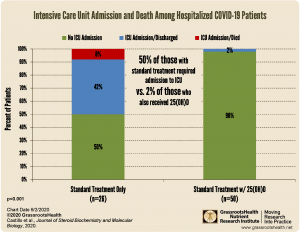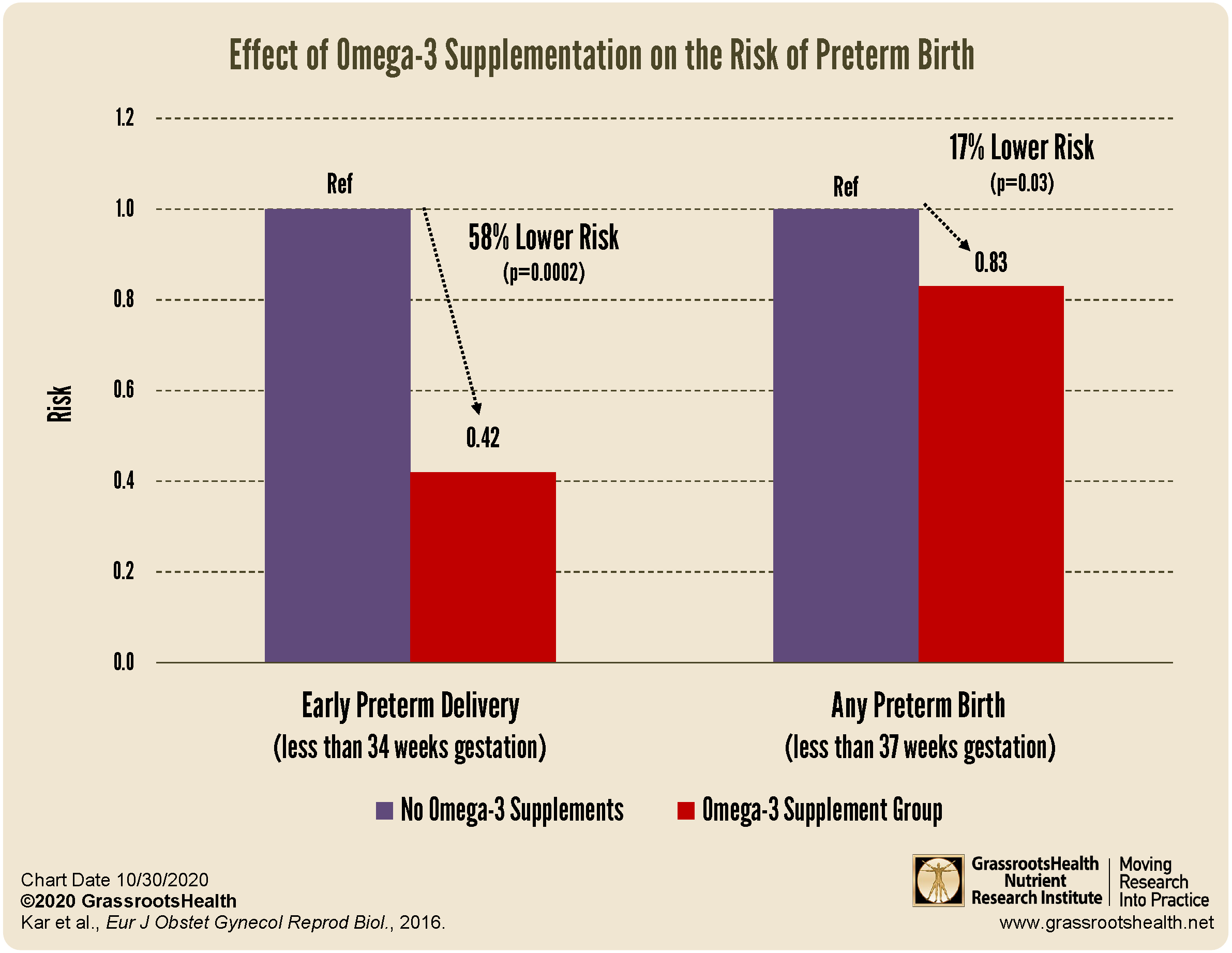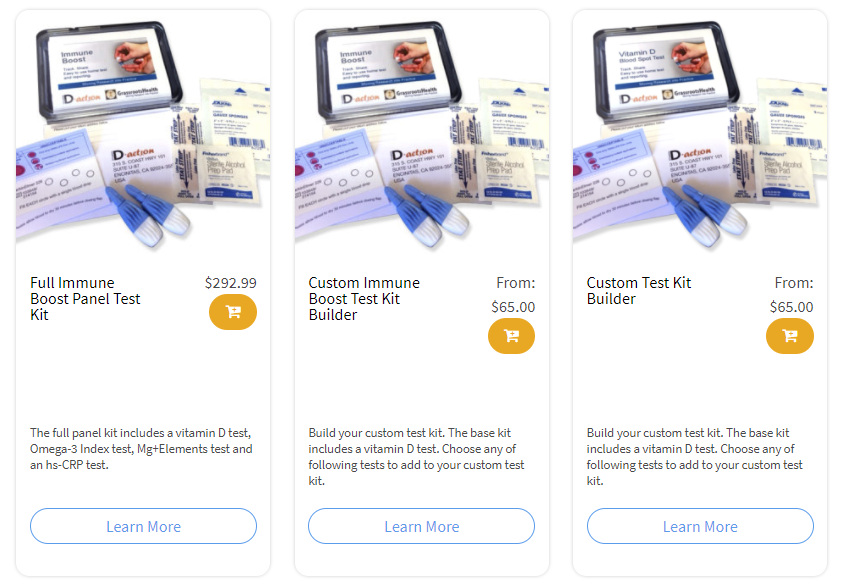Published on November 9, 2020
Meta-analysis of nearly 6000 women shows omega-3 supplementation significantly decreases preterm birth, with a 58% decreased risk of early preterm delivery
 According to the March of Dimes, approximately 15 million babies around the world will be born prematurely this year, and 1 million will die as a result of complications of being born too early. Health care costs are also higher for premature births, with average costs to deliver a premature baby at about $54,000 in comparison with $4,000 to deliver a healthy baby. The March of Dimes also conducts research and puts out a prematurity report card for every region in the country. Their 2019 report announced an upswing in premature birth in the US for the fourth year in a row and an overall ‘C’ rating (10.0%) for the US.
According to the March of Dimes, approximately 15 million babies around the world will be born prematurely this year, and 1 million will die as a result of complications of being born too early. Health care costs are also higher for premature births, with average costs to deliver a premature baby at about $54,000 in comparison with $4,000 to deliver a healthy baby. The March of Dimes also conducts research and puts out a prematurity report card for every region in the country. Their 2019 report announced an upswing in premature birth in the US for the fourth year in a row and an overall ‘C’ rating (10.0%) for the US.
Several studies have shown that achieving a vitamin D level of 40 ng/ml (100 nmol/L) during pregnancy is related to decreased risk of preterm birth and other complications in pregnancy and early childhood. In 2015, GrassrootsHealth partnered with the Medical University of South Carolina (MUSC) to initiate a new standard of care to screen all pregnant women at their hospitals for vitamin D levels and provide them with supplements to help get their levels up to at least 40 ng/ml. Overall, women who got their vitamin D level to at least 40 ng/ml (100 nmol/L) by the time of delivery had a 62% lower risk of preterm birth compared to women with levels under 20 ng/ml (50 nmol/L).
What About Preterm Birth and Omega-3s?
Omega-3s are known to be important for many aspects of health, including being extremely important for vision and for normal brain growth and development during pregnancy and infancy. The beneficial effects may extend beyond this during pregnancy.
Omega-3 fatty acids are also known to provide multiple benefits to prenatal and newborn health. To evaluate the effects of omega-3 supplementation on preterm birth risk, a meta-analysis by Kar et al. combined the data from 9 randomized controlled trials, with a total of 5980 women, to compare the effect of omega-3 fatty acid supplementation on the risk of preterm (<37 weeks gestation) and early preterm (<34 weeks gestation) birth. All women included in the studies had singleton pregnancies and were not on any other treatment for the prevention of preterm delivery. Omega-3 fatty acid intake was identified to include either EPA, DHA or both, with doses ranging from 133 mg per day to 3000 mg per day. Only 1 of the 9 studies gave less than 400 mg per day, and 7 of the 9 studies began supplementation before the end of the second trimester (24 weeks of gestation).
What did the study find?
Six of the studies included early preterm birth as an outcome, and found that omega-3 intake was associated with a 58% reduced risk of early preterm delivery (p=0.0002). Overall, a 17% decreased risk of any preterm birth was seen among women who supplemented with omega-3s (p=0.03).
The review also found that, among the women who supplemented with omega-3s, there was a significant increase in the mean gestational age by nearly two weeks (p=0.01) and a significant increase in the mean birth weight by 122 g (p=0.001).
While additional analysis did not show any significant relationship between risk status and dose or time of omega-3 supplement intake, it is important to remember that the dose of omega-3 intake was greater than 400 mg/day for 8 of the 9 studies included and the majority began supplementation before 24 weeks.
As the authors stated,
“Our review, the largest to-date, has identified that omega 3 fatty acids interventions are effective in preventing early preterm labor which continue to be one of the leading causes of infant deaths worldwide.”
Are You Getting Enough Omega-3s?
GrassrootsHealth offers several testing options to help measure the status of omega-3 and omega-6 fatty acids – the Omega-3 Index, AA:EPA Ratio, and Omega-6:Omega-3 Ratio. Learn more about these tests and the differences between them here. More information on how to improve these test results can be found here.
Using the GrassrootsHealth Custom Kit Builder, you can create a test kit that measures the status of important nutrients (such as vitamin D, omega-3s, and magnesium), as well as your CRP level. Click here to build and order your test kit today – measure your status and take the steps necessary to improve them if needed; make an impact on your health today and for your future! When you know what your levels are, you can determine next steps to take and how much supplementation may be needed if you are not at your target levels.
Concerned specifically about your immune health? See if your immune system might be needing more vitamin D and other immune boosting nutrients by enrolling in the Immune Boost Project with the Full Immune Boost Panel (which includes tests for vitamin D, Omega-3 Index, magnesium, zinc, selenium, copper, and hsCRP), and get 10% off when you use coupon code BoostTen at checkout.
What Does it Take YOU to Get Your D to 40 ng/ml (100 nmol/L)?
Did you know your health could be greatly affected by making sure you have a vitamin D level of at least 40 ng/ml (100 nmol/L)? Help us help you.
STEP 1 – Do you know what your vitamin D level is? If not, be sure to test today to find out.
STEP 2 – Determine your target level. Are you at your target level? Experts recommend a level of at least 40-60 ng/ml (100-150 nmol/L).
STEP 3 – Need to boost your level? Use the D*calculator to see how much vitamin D it may take to reach your target. Opt for the Loading Dose for a quicker boost.
STEP 4 – Optimize how your body absorbs and utilizes vitamin D with co-nutrients and these simple steps.
STEP 5 – Re-Test! This is an important step to make sure you have reached your target level, and to ensure you are not taking too much! Re-testing after 3-4 months is recommended.
STEP 6 – Adjust, Repeat…
Give your immune system the nutrients it needs to support a healthy you and protect yourself from unnecessary diseases, especially COVID-19.
NEWS ALERT
 The first Randomized Controlled Trial on vitamin D and COVID-19 has shown a 96% lower risk of ICU admission for those receiving vitamin D (as 25(OH)D to quickly boost vitamin D blood levels) along with the standard treatment, compared to those receiving standard treatment alone.
The first Randomized Controlled Trial on vitamin D and COVID-19 has shown a 96% lower risk of ICU admission for those receiving vitamin D (as 25(OH)D to quickly boost vitamin D blood levels) along with the standard treatment, compared to those receiving standard treatment alone.
These results support many previous observational studies showing a relationship between vitamin D levels and intake and COVID-19 severity.
Review the Latest Nutrient Research for COVID-19
GrassrootsHealth Nutrient Research Institute has launched the new Immune Boost project with the use of our myData-myAnswers nutrient health system that nearly 15,000 people are already using for their health. Specific markers that influence immune health are suggested for testing as part of this project including:
- Vitamin D
- Omega-3 Index
- Essential elements magnesium, selenium, and zinc
- hsCRP
Our goal is to demonstrate how one can use the Nutrient Research Model established by Dr. Robert Heaney to show the effect of vitamin D serum levels of at least 40 ng/ml (100 nmol/L) on risk reduction for all ethnicities in the population. Status and intake of other nutrients will also be analyzed for any type of relationship to immune status and symptom severity. Join the project today!
Please let us know if you’re interested in helping sponsor this project.
Through GrassrootsHealth Nutrient Research Institute, you can also test your essential elements magnesium, copper, zinc and selenium, toxins such as lead, mercury and cadmium, as well as your omega-3 levels, inflammation levels and thyroid stimulating hormone (TSH) level. Find out your levels today! Log on to the test selection page (click the link below) to get your tests and see for yourself if your levels can be improved.
Make sure you track your results before and after, about every 6 months!
Click Here to Access the Test Page
How can I track my nutrient intake and levels over time?
To help you track your supplement use and nutrient levels, GrassrootsHealth has created the Personal Health Nutrient Decision System called
For each specific supplement, you can track what days you take it, how much, and many other details. This will help you know your true supplemental intake and what patterns of use work for you to reach and maintain optimum nutrient levels. Check it out today!










